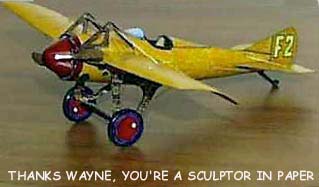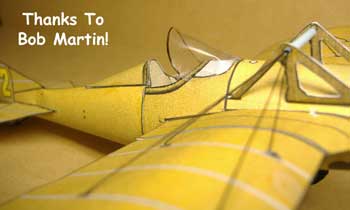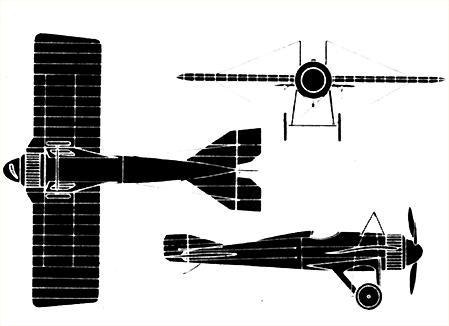



Deperdussin-Racer - $$4.95
Designed as a racing aircraft, the Deperdussin Monocoque was a slim, single-seated plane with a sleek aerodynamic build that was the first of a large range of similar designs that would come in later years. The design is noted for winning the Gordon Bennett Trophy in 1912.
The Bechereau Deperdussin 1913 Racer


The Bechereau Deperdussin Racer was perhaps 15 years ahead of it's time with new and innovative streamlining.
Not surprisingly, it won many races and records and is, IMHO, the first real racing plane.
The best-known Deperdussin aircraft was this little Monocoque racer, which had exceptionally clean lines... in it Maurice Prevost set a world speed record in September 1913.
Chip, I humbly send to you a couple of pix of your Deperdussin Racer (1913)....The "shine" comes from the gum arabic I've gone on about in the past...The "nose" is a combination red-tinted "Elmers" with a couple of final coats of red-tinted gum arabic. Many thanks for your work. The Racer CD is definitely a keeper .Wayne

Deperdussin 1913 Racer

Bechereau designed a series of monoplanes of increasing capability, perfecting a monocoque form of fuselage construction that combined a desirable circular cross-section with light weight and strength. Typically, the Deperdussin's were braced high-wing monoplanes, two king-posts on the forward fuselage carrying a skein of wires to brace the slender wings Lateral control was by wing warping. Landing gear was normally of fixed tailskid type, but sea plane versions had, for their day, a very neat float installation Power was provided for most of the range by Gnome rotary engines of various power outputs.

A first major success came on 9 September 1912, when a Deperdussin powered by a 160hp Gnome and piloted by Jules Vedrines won the fourth James Gordon Bennett Aviation Cup race at Chicago, Illinois. Even greater were the achievements of 1913, Maurice Prevost winning the first Schneider Trophy race at Monaco on 16 April, the Gordon Bennett Cup at Reims, France, on 29 September, and setting a world absolute speed record of 126.67 mph on the same date To complete the year's achievements, a Deperdussin piloted by Eugene Gilbert won the Henry Deutsch de la Meurthe air race around Paris on 27 October. Thus, in a few months Bechereau and Herbemont had created for Deperdussin the world's fastest prewar aeroplane from this pinnacle of achievement came collapse of the Deperdussin company. It was taken over by Louis Bleriot and renamed Societe Pour L'Aviation et ses Derives (also SPAD), which gained fame for its products during World War I.


The first plane to break the 124 mph 'barrier', and the first Schneider Trophy winner, was Armand Deperdussin's monoplane. It was the 'speed phenomenon' of the years before the First World War. The plane was developed early in 1912 by Louis Bechereau, the designer for the Socie'te pour les Appareils Deperdussin. Bechereau worked from an idea by Swedish engineer Ruchonnet, and developed a streamlined monocoque plywood fuselage with a large spinner. To achieve maximum power two Gnome rotaries were mounted on a common crankshaft. The first noteworthy achievement of this plane was the 1912 Gordon Bennett Cup, which it won with a speed of 108.1 mph. The plane won the cup again the following year, on September 29,1913 in Reims, Maurice Prevost achieving an average of 124.6 mph . During this race the plane beat the world speed record three times, and its maximum speed was 126.7 mph.
A few months earlier, in April 1913, Prevost had won another exceptional victory at the controls of the floatplane version of the Deperdussin monoplane: first place in the first race for the Schneider Trophy in Monaco, with an average speed of 45.75 mph . The low speed was due to the fact that the judges made Prevost repeat his take-off and about six miles of the course because of a supposed violation of the rules. This Deperdussin victory was the only time in the history of the Schneider Trophy (1912-31) that France won a race.

Specifications for the Deperdussin Monocoque Racer
 |
Wing area: 104 sq ft Weight: 1.350 lbs Frame: ash Covering: plywood, linen Engine: Gnome 14-cylinder air-cooled rotary, 160 hp Performance Speed :130 mph |



 |
The Deperdussin Racer in the opening image, is housed in the Owl's Head Museum. This is an image of the Owl's Head Lighthouse overlooking the Museam. |

Old Rhinebeck Aerodrome Static Exhibit
Bechereau Deperdussin 1913 Racer
The Bechereau Deperdussin 1913 Racer, designed by French engineer Louis Béchereau for the Société Pour les Appareils Deperdussin (SPAD), was a pioneering monocoque monoplane that revolutionized aviation with its streamlined wooden shell fuselage, setting world speed records and dominating early air races. Powered by a 160-hp Gnome 14-cylinder rotary engine driving a two-bladed propeller, it featured a wingspan of 6.65 meters, length of 6.1 meters, and empty weight of 425 kg, achieving speeds up to 210 km/h (130 mph) and winning the Gordon Bennett Trophy in both 1912 and 1913 with pilots Jules Védrines and Maurice Prévost. Its innovative shoulder-mounted wing, tapered design, and minimal bracing reduced drag, allowing it to cover 200 km in just 59 minutes 45 seconds during the 1913 race at Reims, France. As a precursor to World War I fighters, the Deperdussin influenced later SPAD designs; only a few were built before the company's bankruptcy in 1913 due to financial scandals, but replicas and survivors highlight its role in advancing aerodynamics and speed in the pre-war era. This elegant racer embodied the Golden Age of Aviation's spirit of innovation and competition.


